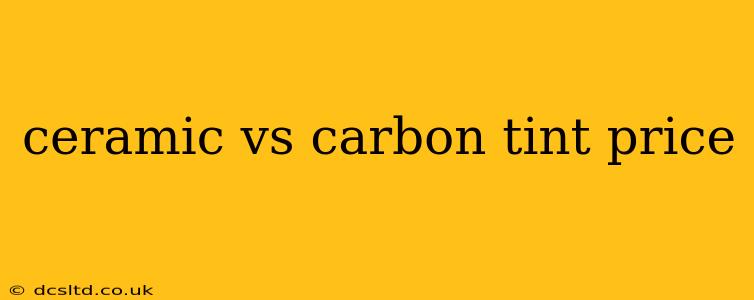Ceramic vs. Carbon Tint: A Price Comparison and Deep Dive
Choosing between ceramic and carbon window tint often comes down to budget and desired performance. While both offer superior heat rejection compared to standard dyed films, their pricing structures differ significantly, impacting the overall cost of your vehicle's upgrade. This article breaks down the price differences and explores the factors that contribute to them.
What Factors Influence the Price of Window Tint?
Several factors influence the final cost of both ceramic and carbon tint installations:
-
Type of Film: The quality and brand of the film are primary drivers. Premium brands with advanced technology and superior performance typically command higher prices. Within each category (ceramic and carbon), you'll find a range of options with varying price points.
-
Vehicle Size: Larger vehicles like SUVs and trucks require more film, naturally increasing the total cost.
-
Number of Windows: Tinting more windows (e.g., sunroof, rear windshield) will add to the overall expense.
-
Installer Expertise: Experienced installers with a reputation for quality work often charge more than less experienced technicians. Their expertise ensures a professional, bubble-free application.
-
Location: Labor costs vary by region. Installation in higher-cost-of-living areas will typically reflect higher prices.
-
Additional Features: Some films offer extra features like infrared (IR) rejection, signal compatibility (for things like GPS and toll transponders), or added warranties. These enhancements usually increase the price.
How Much Does Ceramic Tint Cost?
Ceramic tint typically falls into a higher price bracket than carbon tint. The price per window can range from $75 to $200 or more, depending on the factors listed above. A full vehicle tint can cost anywhere from $300 to $1000 or more.
The higher cost reflects the advanced technology and superior heat rejection properties of ceramic films. They generally offer better UV protection, reduce glare significantly, and maintain better clarity than other types of tints.
How Much Does Carbon Tint Cost?
Carbon tint offers a more budget-friendly option compared to ceramic. You can expect to pay $50 to $150 per window, or $200 to $600 for a full vehicle tint.
While not as effective at heat rejection as high-end ceramic films, carbon films still provide substantial improvements over standard dyed films and offer excellent UV protection.
Which is Better Value? Ceramic or Carbon Tint?
The "better value" depends entirely on your priorities and budget.
-
For superior heat rejection, UV protection, and longevity: Ceramic tint is often the better value, even at a higher initial cost. It will potentially save you money on fuel in the long run (reduced need for AC), and may last longer, thus reducing the need for replacements.
-
For a budget-friendly option with good performance: Carbon tint offers a cost-effective alternative that still provides significant improvements over standard films.
Ultimately, the best choice requires carefully weighing your budget against the long-term benefits of each option.
What are the Main Differences Between Ceramic and Carbon Tint?
This is a common question when considering which tint is right for you. The key differences lie in their composition and performance characteristics.
-
Composition: Ceramic tint utilizes ceramic nanoparticles embedded within a polyester film, resulting in superior heat rejection and UV protection. Carbon tint, in contrast, uses carbon particles or layers for heat rejection.
-
Heat Rejection: Ceramic generally offers superior heat rejection capabilities, often exceeding 60% on the high end, while carbon film can typically manage a range between 40-50% depending on the film quality.
What is the best tint for heat rejection?
For ultimate heat rejection, high-end ceramic tints are generally considered the best option. The specific performance numbers vary depending on the manufacturer and the film's specifications.
How long does window tint last?
The lifespan of both ceramic and carbon tints varies. However, with proper care and installation, high-quality films can last for 5 to 10 years or longer. However, factors like exposure to sunlight and climate can affect the longevity of the film.
This detailed comparison should help you make an informed decision when choosing between ceramic and carbon window tints, considering their respective price points and performance characteristics. Remember to always get multiple quotes from reputable installers to ensure you're getting the best price for the quality you desire.
